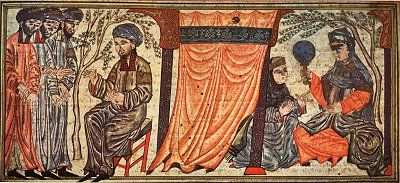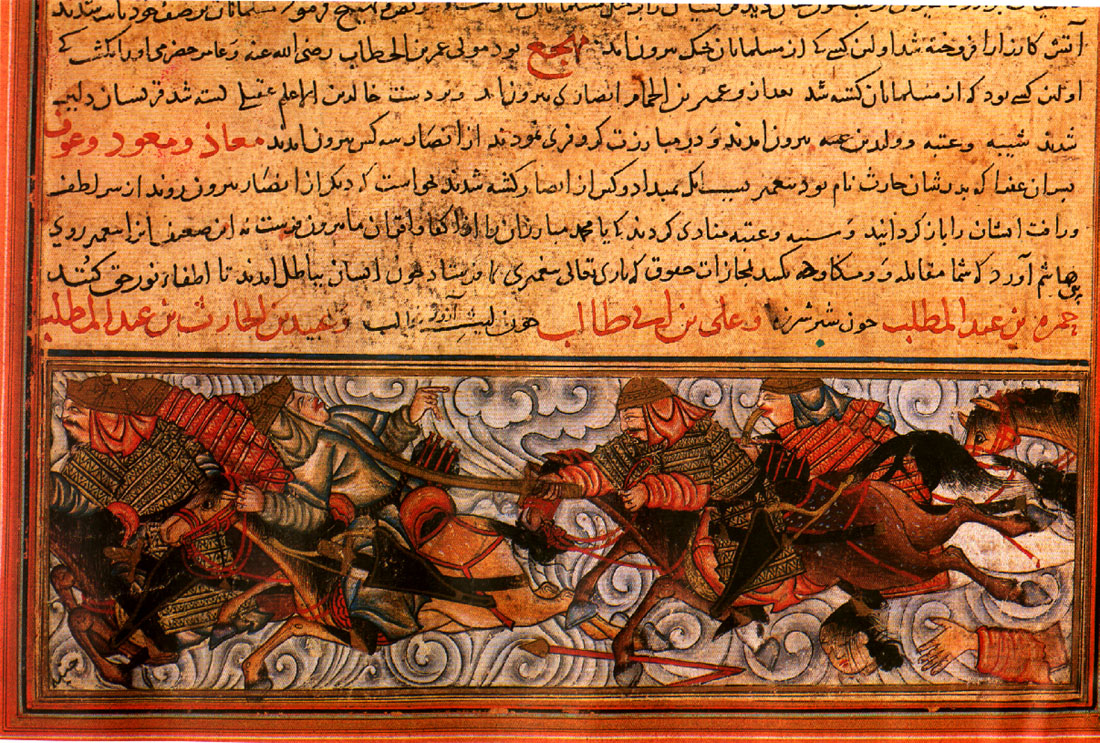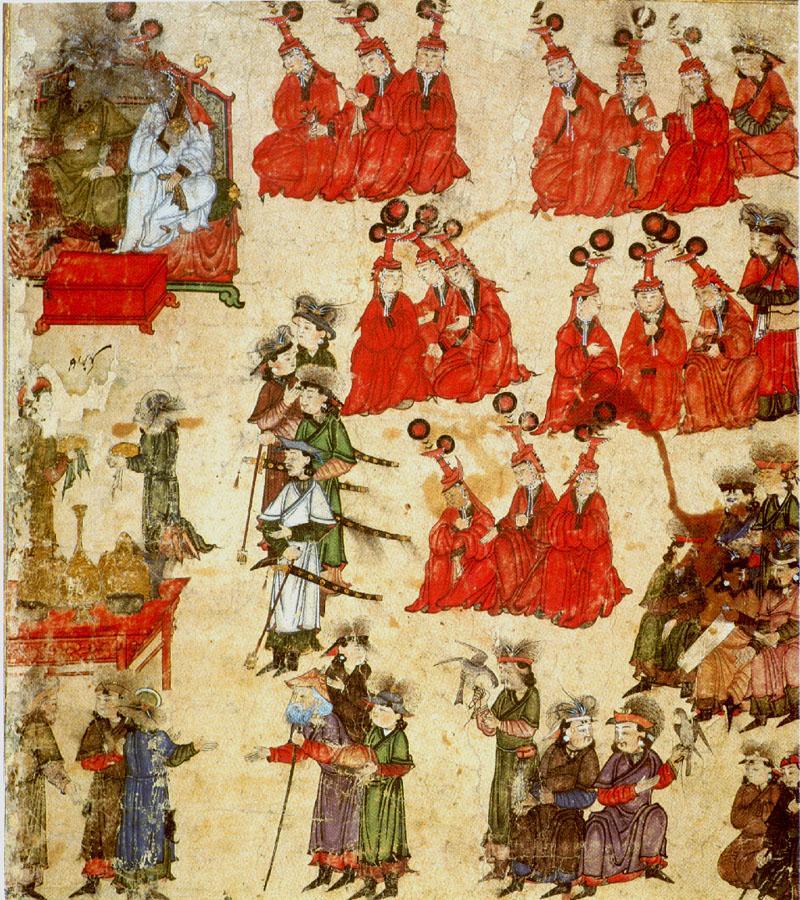A History of the World
�
Written by Paul Lunde and Rosalind Mazzawi
�

Abraham receiving the Three Strangers and Sarah in the tent
Illustration from Jami' al-Tawarikh of Rashid al-Din. Tabriz, 1314
�
On July 8, 1980, an illuminated manuscript in Arabic, 120 pages long, was sold at Sotheby's in London for ?850,000 - $2,017,050 - to a firm of Swiss lawyers acting for an unidentified client. The price - which works out to about $16,790 a page - was the highest ever paid for an Arabic manuscript.
Even in today's overheated art market, the price paid for this manuscript - Jami' al-Tawarikh, ("Compendium of Histories") - is astonishing. Though it is very old -exactly 666 years when sold -and is lavishly illustrated, to fully understand its importance it is necessary to go back to the single greatest upheaval of the Muslim Middle Ages: the Mongol conquests of the 13th century. Without the Mongol conquests there would have been no manuscript auctioned at Sotheby's.
In 1215, while the West was occupied with the Crusades and the Arab East with bitter dynastic quarrels, the Mongol tribes of Central Asia, united under Genghis Khan, sacked Peking and turned towards Transoxania and the wealthy lands of Khwarizm (See Aramco World September-October 1979). By the time Genghis Khan died, in 1227, the Mongols were poised to strike at the lands of Islam and 29 years later - after invading Russia, China and Southeast Asia - they moved on the heartlands of the Abbasid Caliphate; Iran and Iraq.

Pursuit Scene from the Battle of Badr
Jami' al-Tawarikh ('Universal History' of Rashid al-din).
Rashidiyya, 1314.
Hazine 1653, folio 165b
The attack on the Islamic world began on January 1, 1256, when Hulagu Khan, grandson of Genghis and brother of the Great Khan of China and Mongolia, crossed the Oxus River and passed into Iran. After receiving the homage of the petty rulers of northern Iran and the Caucasus, he moved against the Assassins, a fanatic sect which had terrorized the orthodox Islamic world, and, in 1257, destroyed the Assassins' castle of Alamut, the lair of the Grand Master. Among the prisoners released, when Alamut was taken, was the grandfather of Rashid al-Din Fadl Allah Abu al-Khair, the author of the work auctioned at Sotheby's on July 8,1980.
A year later, in 1258, Hulagu, in one of the turning points of history, sacked Baghdad. Hulagu, in fact, was under orders Caliphate, which had ruled for more than 500 years, and assumed the mantle of power that, before 1258, had rested largely with the Arabic speaking peoples of the Middle East. After 1258, hegemony passed to the Turkic and Mongol peoples who had poured out of Central Asia.
The Mongols did not stop with Baghdad. Hulagu, in fact, was under orders to reach Egypt, and soon after the fall of Baghdad took Aleppo and Damascus in Syria. But in 1260, on receiving news of the death of the Great Khan, Hulagu hurried back to the Mongol heartlands to attend the election of his successor. During his absence the Mongol hordes suffered a crushing defeat - their first - at the hands of the Mamluks at 'Ain Jalut ("The Well of Goliath") in Palestine. Thus Egypt and much of Syria, were spared but Iraq and Iran found themselves under Mongol rule.

Mongol Ruler and consort enthroned
Jami' al-Tawarikh ('Universal History' of Rashid al-din).
Il-Khanid Tabriz, 1330.
Hazine 1653, folio 23a
It was into this world, so similar to our own, with its violent upheavals, that the historian Rashid al-Din, the author of the fragment of the Jami' al-Tawarikh sold at Sotheby's, was born. It is a curious irony that the terrible events of the 13th century were responsible for the elements which make his book unique.
Rashid al-Din, born in 1247, came from a long line of distinguished scholars. His grandfather, for example, on his release from the castle of Alamut, had entered the service of Hulagu Khan, and set a precedent for government service under the new Mongol rulers which Rashid al-Din followed; he entered the service of Abaqa Khan, one of Hulagu's three sons, as court physician.
When the Mongols arrived in Iran, they had already been exposed to religious and cultural influences of the most diverse kinds; the hordes of Hulagu contained Shamanists, Buddhists, Muslims and Nes-torian Christians, an Eastern sect centered in Iran and Iraq. But as in China, where they had been quick to adopt its language and customs, the Mongols eventually accepted the Persian language and the Islamic religion - without, however, abandoning entirely their connection with the Far East.
This mixing of cultures and religions, the product of the geographical extension of the Mongol Empire, is reflected in the historical works of Rashid al-Din. They deal with all the peoples with whom the Mongols came into contact and for the first time treat history on a universal scale. His works, in effect, provided a history of the whole world of that era.
The Mongols were also in constant diplomatic contact with Europe. Abaqa Khan, for example, sent a number of embassies to the Christian powers, who were interested in cultivating the Mongols. One reason was the Mongols' enmity towards the Mamluks - 'Ain Jalut had not been forgotten. Another was Europe's belief in Prester John of the Indies, a legendary Christian ruler in the Far East with whom several popes had sought an alliance to outflank the Muslim powers of the Middle East.
These legends of Prester John were not without some foundation: Doquz Khatun, the wife of Abaqa's father Hulagu, was a Christian and consistently interceded on behalf of those Christian communities so unfortunate as to find themselves in the path of the Mongol hordes. Her father, in turn, was Khan of the Christian tribe of the Kera'its.
Meanwhile, the initial - almost unbelievable - destruction wrought by the Mongols was giving way to what has been termed, with only slight irony, the Pax Mongolica. The Mongols, engineers of what has been described as "one of the most dreadful calamities which ever befell the human race," soon established order throughout their vast possessions and for the first time since classical times, communications between Europe and the Far East became safe and practical. Ambassadors and envoys began to flock to Karakoram, capital of the Golden Horde, and to Peking, where the great Kublai Khan reigned. In return, two Mongol ambassadors turned up in Northampton, in 1307, bearing letters to Edward II.
As had Hulagu Khan before him, Abaqa Khan actively supported the Buddhist faith. He built temples and encouraged Buddhist monks to settle in his dominions. Yet, like all of the Mongol rulers, he also seems to have been extremely interested in what can only be called comparative religion. A favorite entertainment, described by William of Rubruck, a papal envoy to the Golden Horde, was debates by adherents of the different faiths before the Khan, who awarded prizes to those who argued most convincingly for their point of view.
Because of the barbarous cruelty of the Mongol hordes, these intellectual interests may seem surprising, but the two - unfortunately - are not mutually exclusive Hulagu - the man who cast the libraries of Abbasid Baghdad into the Tigris until the water of that river ran with their ink - also founded the most up-to-date observatory in the Middle East at Maragha, and the Ilkhans - the dynasty founded by Hulagu -consistently patronized scholars and raised them to high positions. Rashid al-Din is only the most notable of many similarly favored.
When Abaqa died in 1282, a period of unrest followed. His brother Ahmad, a Muslim, as can be seen from his name, briefly took power, but when he sought to heal the breach with his co-religionists, the Mamluks of Egypt - despite their second, humiliating defeat of the Mongols in 1277 - he was deposed by Mongol hard-liners and replaced by Arghun, one of Abaqa's sons, in 1284. Arghun, in turn, was succeeded by his brother Ghaikhatu who won a sort of fame by trying to introduce paper money -and single-handedly ruining the economy of the Ilkhanid state when merchants and soldiers alike refused to accept the strange block-printed currency. Disorders erupted and by the time Ghazan Khan came to power, in 1295, the situation was chaotic: public disorder, government corruption and disastrous fiscal policies. Worse, the postal system, the most vital Mongol institution, had broken down, and Ghazan, faced with a formidable task of reorganization, chose Rashid al-Din to undertake it.
Until then Rashid al-Din seems to have been in the shadows. From what he wrote, it seems clear that he was an important official quite familiar with the various peoples who sent emissaries to Hulagu Khan, Abaqa Khan, Ahmad, Arghun and Ghaikhatu. But it was under Ghazan that he came to the fore. In 1295 Ghazan chose Rashid al-Din as his vizier, confided virtual control of the government to him and, recognizing his vizier's scholarly gifts, chose him to be the official chronicler of the Mongol conquests.
Behind Rashid's appointment as chronicler was a momentous event. On June 19, 1295, Ghazan and 10,000 of his most loyal followers publicly embraced Islam. Coins were issued bearing Islamic inscriptions, and four years later the Mongol princes formally adopted the turban, abandoning their traditional head-gear with its non-Islamic associations. This was momentous because it marked a decisive break with the Mongol past and the absorption of the conquering race by the dominant Islamic culture. On the other hand, Ghazan, though learned in Islam and a supporter of the faith, did not wish the national traditions of the Mongol people and the story of their extraordinary conquests to be forgotten.
To facilitate Rashid al-Din's work, Gha-zan placed the state archives at the disposal of the historian, including the Altan Debter, the "Golden Book", or official history of the ruling family, as well as his own deep ' knowledge of both the historical and the legendary Mongol past and his interest in sciences and languages; he spoke Mongolian, Chinese, Arabic, Persian, Tibetan and Kashmiri. He also brought Rashid al-Din together with Pulad Chinksank, representative of the Great Khan of China at the Mongol court, who was able to give Rashid al-Din precious details on the history of the Mongol conquest of China.
Unfortunately for Ghazan, he did not live to see the history of the Mongols completed. He died in 1304. But his successor, Uljeitu, encouraged Rashid al-Din to continue the work and in 1307 the first volume of the jami' al-Tawarikh was completed; it was called the Tarikhi-Ghazani, or "Ghazanian History," in honor of Rashid al-Din's patron.
This book, which fortunately survives, is one of the prime sources on the history of the Mongols and much of it is based on information supplied by Ghazan himself to Rashid al-Din. It contains the history of the Turkish and Mongol tribes, including their tribal legends, geneologies, myths and the history of the Mongol conquests from the time of Genghis Khan to the end of the reign of Ghazan Khan. Uljeitu was so pleased with it that he encouraged Rashid al-Din to supplement it with two more volumes: one on the history of all the peoples with whom the Mongols had fought or with whom they had exchanged embassies, and a third on historical geography. This final volume may never have been written - or if it was it has not survived -but the second definitely was; the manuscript auctioned at Sotheby's contains portions of it.
The fact that Rashid al-Din was vizier during a period of massive reform both hindered and helped him. He obviously had little time to work on his chronicles, but his position also gave him access to vast amounts of information. It permitted him, furthermore, to take unusual measures to insure that his works survived. Indeed, few authors in history have taken such care to ensure the survival of their works.
Because of his high position - it was said by a slightly later historian who knew him that he was the most highly paid civil servant in history - Rashid al-Din possessed the means to do so. He founded a suburb of Tabriz, the Ilkhanid capital, named after himself the Rab' i-Rashidi, or "Suburb of Rashid," the main industry of which appears to have been the production of copies of his works.
The Rab' i-Rashidi was enclosed in the great wall, 25,000 paces in circumference, which Ghazan Khan had erected to serve as a customs barrier. It lay on the slopes of Mt. Valiyan, was built at the personal expense of Rashid al-Din, and its endowment provided for Koran readers, theologians, a physician, a surgeon and 12 medical students. The suburb contained mosques, markets, a bath and a library -in which Rashid al-Din set up a system to produce as many copies of his works as possible in order to guard against oblivion.
Under this system he had copies made lent them to friends, and urged them to transcribe them and return the originals. He had Arabic translations made of those works he composed in Persian, and Persian translations of works composed in Arabic. When the translations had been prepared, he deposited them in the mosque library of theRab'i-Rashidi.
Rashid al-Din also collected all of his compositions into a single volume, entitled Jami' al-Tasanif al-Rashidi ("The Collected Works of Rashid"), complete with maps and illustrations. He even had some of his shorter works, on medicine and government, translated into Chinese. Anyone who wished was given access to his works and encouraged to copy them. In order to facilitate this, he set aside a fund to pay for the annual transcription of two complete manuscripts of his works, one in Arabic and one in Persian.
These copies were written on the finest paper by the most skilled scribes, carefully collated with the originals to make sure that they contained no errors, and, when finished, were illustrated, bound and carried into the mosque where a special prayer, composed by Rashid al-Din, was recited (See above). The same prayer was written at the end of each copy, followed by a colophon indicating the name of the town for which the manuscript had been copied and the name of the administrator of the endowment (waqf). The manuscript was then sent to a committee composed of the qadis of Tabriz, who certified that the wishes of the author had been carried out.
Even then Rashid al-Din was not satisfied. The finished books were sent to the towns for which they were destined and deposited in the public libraries, where they could be consulted by the public, and even borrowed, on deposit of a fee. At the foundation, professors were appointed to read and expound the complete works of Rashid al-Din - he composed a number of theological and scientific works as well as historical - and one of the terms of their appointment was that each professor had to make a copy of Rashid al-Din's collected works during the course of his lectures. If he failed to do this, he was dismissed and replaced.
Ironically, given the immense effort that was made, Rashid al-Din failed, proving that even historians are at the mercy of�history. Although the text of the Jami' al-Tawarikh hag survived in a number of later copies, all the magnificent productions of the scriptorium at Rab' i-Rashidi have perished - with two exceptions. One extensive portion, with the original illustrations, survives in Edinburgh; the other is the Royal Asiatic Society manuscript auctioned at Sotheby's.
The reason so few productions of Rashid al-Din's scriptorium survived, despite his elaborate precautions, lies in the political events that led to his downfall. As noted, Uljeitu had confirmed Rashid al-Din in his position and heaped additional honors on him as well. As a result, Rashid al-Din was able to construct two more suburbs, one outside the new capital of Sultaniyya, named after its builder "Rashidiyya," and the other east of Tabriz, both financed with the enormous sums Uljeitu lavished upon him, sums never before received by any minister from his sovereign.
In the year 1312, however, things began to go badly. His colleague, Sa'd al-Dawla, fell from power and was replaced by 'Ali Shah, who soon began intriguing to bring down Rashid al-Din. Then, in 1314, Uljeitu died and power passed to his son, Abu Sa'id. Young and inexperienced, Abu Sa'id sided with 'Ali Shah and on July 18, 1317, Rashid al-Din, at the age of 70, was put to death on the obviously trumped-up charge of having poisoned Ghazan Khan. His property was confiscated and - even worse from the standpoint of both art and history - Rab' i-Rashidi, with its scriptorium and its precious copies, was turned over to the Mongol soldiery. Only two fragments of the Jami' al-Tawarikh have survived, one of them the manuscript sold at Sotheby's last year.
Paul Lunde is a staff writer for Aramco World.
Rosalind Mazzawi, formerly of Beirut, has contributed several articles to Aramco World.




